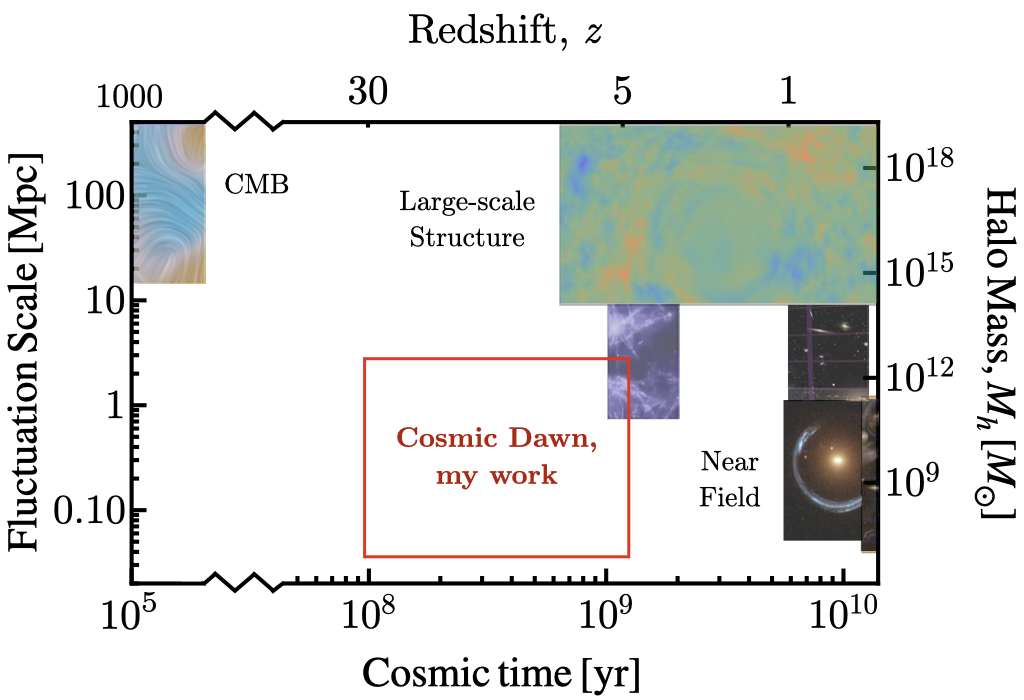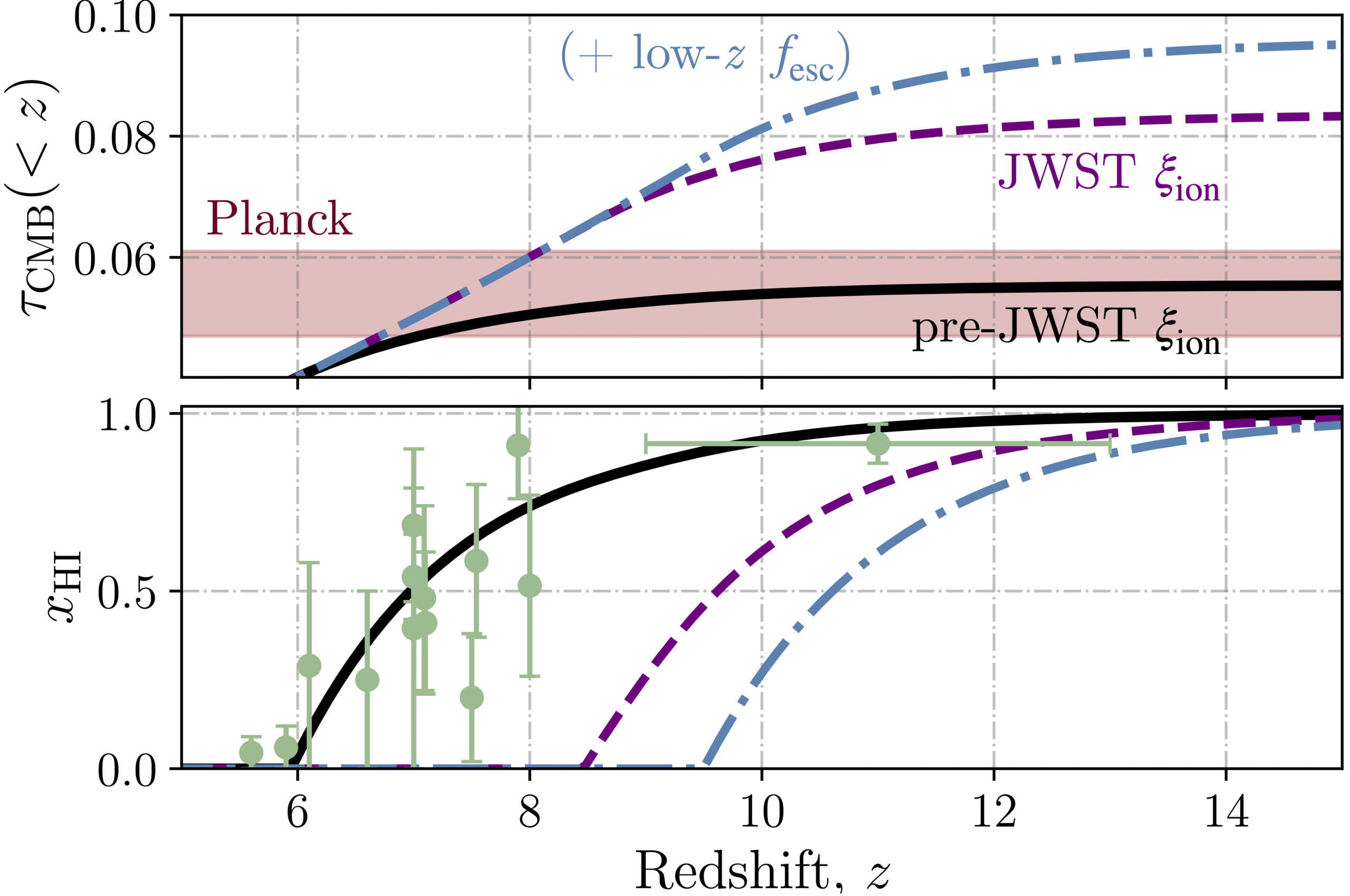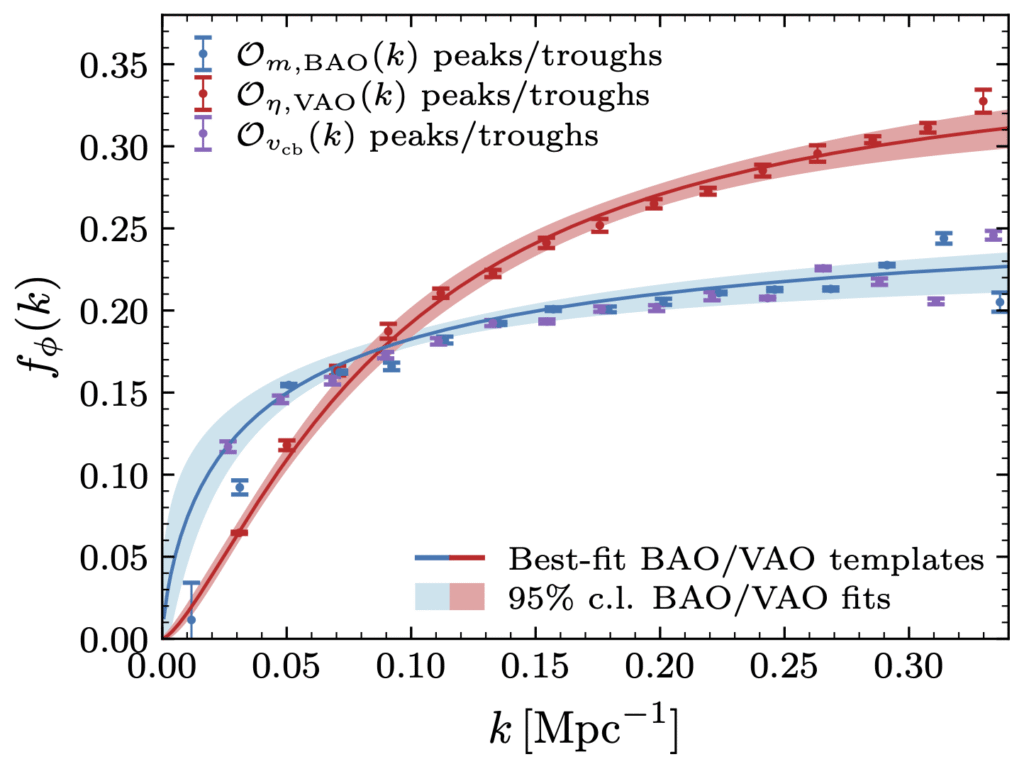I’m broadly interested in early-universe astrophysics and cosmology. My recent work has been on understanding the epochs of cosmic dawn and reionization, especially on how the first galaxies formed on dark-matter halos and contributed to reionization. In short, my work aims to fill the gap on how structure forms at small scales and early times in the universe, as in the figure below (from Sabti, JBM+2021). This program will complete our picture of how dark matter grew structures from the Big Bang until today, using data from cutting-edge facilities like JWST, HERA, and HETDEX.

Some recent talks I have given are:
-the Clay Lecture on Cosmic Dawn that I gave at the Harvard-Smithsonian CfA (2022), or
-an invited seminar at UIUC on JWST puzzles (2024), and
-an invited review of JWST for particle physics and cosmology at the HEP/Astro forum (2025, link).
You can find the codes that I have written in the GitHub, including:
Zeus21: An analytic code for 21-cm at cosmic dawn
Simple-Reionization-Plot: To make xHI and tauCMB vs z plots of reionization
21cmvFAST: 21-cm simulations to include dark matter-baryon relative velocities.
RelicFast: a code to find scale-dependent bias from light relics and massive neutrinos.
I have also contributed to developing 21cmFASTv3 (see EOS21 page) and GALLUMI (link, see below).
Here is a list of some of the topics I’m excited about, and some of the cool results my group has found over the last few years. If you’re interested in any of this please get in touch!
21-cm Cosmology
A big part of my work is on extracting cosmology and astrophysics from 21-cm data. Here are some examples.
Velocity-induced Acoustic Oscillations (VAOs)
In two companion papers (1 and 2) I introduced 21cmvFAST, a version of 21cmFAST that included the effect of the dark matter-baryon relative velocities on the first galaxies. I showed that these produce velocity-induced acoustic oscillations (VAOs, or wiggles) in the 21-cm signal during cosmic dawn, which can be used as a standard ruler to cosmic dawn (z=10-20). In this paper I made the velocities part of the standard 21cmFAST software, and updated our reference 21-cm models of the first galaxies (see EOS21 for details and nice animations).
21-cm as a dark matter detector:
I have also developed the 21-cm line as a tool to learn about dark matter (DM). Here we argued that cosmic dawn is an ideal location to search for millicharged DM, and that only a sub-percent fraction of the DM is required to explain the EDGES anomaly at z=17. I have led the HERA theory analysis of DM, and found more stringent limits, though at z=8-10. Upcoming high-z HERA data will be able to test the origin of the EDGES depth, if real. The 21-cm line also has information about the timing of the first galaxies, which in this paper I showed makes it is sensitive to the small-scale nature of dark matter, at much higher wavenumbers than currently accessible (k~50/Mpc). This can help identify self-interacting DM, like in the ETHOS models.
Mapping reionization and cosmic dawn:
The future of 21-cm is to map the fluctuations across many redshifts and scales, which show a rich phenomenology of processes, ranging from heating of the IGM (likely due to high-mass X-ray binaries), to its reionization (due to galaxies of different masses). Key to understand all these processes are fast simulations across a range of scales. These are needed to explore the vast astrophysical—and cosmological—parameter space. Below I show a lightcone of the 21-cm signal across cosmic dawn and the EoR, along with the densities that seed the fluctuations.

Finding the first stars:
If you’re curious to see how we can use 21-cm to detect and understand the first PopIII stars that formed in the universe, you may be interested to see the EOS 2021 (the Evolution of Structure in 21-cm, 2021) simulations. Here is an entire page dedicated to this project that you can peruse: EOS 2021 simulation project
Simulating the first billion years in seconds:
Most recently I have introduced an effective model for the 21-cm signal, based on log-normal fields. You can find it in Muñoz23 and in the public software package Zeus21 (Git). This code can reproduce the results of expensive simulations in ~1 s, and gives us a new way to find the evolution of the 21-cm signal across cosmic dawn. To give you an idea, here is the prediction of Zeus21 against the popular 21cmFAST simulations for 3 different astrophysical parameter sets. Top panel shows the global signals, and bottom is the power spectrum at k=0.3/Mpc. Solid lines are Zeus21, which can reproduce the simulations (dashed) really well, and very fast!
We enhanced this code to include PopIII stars in Cruz+24, and to do line-intensity mapping in Libanore+25 through oLIMpus (see Sarah’s code!) We’re currently working to model reionization analytically as well.


Top: Limits on the spin temperature (divided by the CMB as a radio background) as a function of redshift derived from HERA and EDGES observations.
Analyzing HERA observations:
All these simulations and predictions are not just beautiful pictures, but also signals to compare with the results of current and upcoming 21-cm experiments. I’m a member of HERA, where we have been able to set the deepest limits on the 21-cm power spectrum during reionization (z=8-10), and are now pushing to do the same at cosmic dawn (z=14-20). I lead the dark-matter theory group in HERA, and have worked on translating the 21-cm limits into inferences on the spin temperature of gas during unexplored eras. See for instance the plot I made with a summary of the first HERA limits, in our first interpretation paper (see also the most recent one, with a similar plot, here).


Cosmology from HST/JWST
Another topic I’m very keen on investigating is what cosmology we can learn from JWST and HST observations. Many of us are familiar with the beautiful Hubble ultra-deep field images. Not only do these teach us a lot about the formation of the first galaxies during the epoch of reionization, but also about the nature of dark matter and other cosmic mysteries.
How does dark matter cluster?
In these two papers (1 and 2, led by grad student Nash Sabti) we developed a pipeline to measure the clustering of matter at z=4-10 marginalizing over the astrophysical uncertainties of this era (chiefly the unknown halo-galaxy connection). We obtained a measurement of the matter power spectrum up to k=10/Mpc, reaching smaller scales—and earlier times—than other cosmic probes. Our measurement (black crosses) is shown along with other cosmic data (compiled in this paper, all linearly extrapolated to z=0, where the standard LCDM prediction is the black line) in this figure. The UVLFs allow us to access the unknown era of z=4-10 at smaller scales than we currently probe (albeit only at ~30% precision!) We used a similar technique to constrain primordial non-Gaussianity at small scales here.
Does JWST break our cosmological models?
Following on this work, we set out to test if JWST is breaking our cosmological models. In particular we seeked for enhancements of power that could explain the overabundance of ultramassive galaxies claimed to have been observed in JWST (see Labbe+23 and Boylan-Kolchin 23). We used the same HST data (taken over decades!) to show that extra structure formation in a way that would produce more dark-matter halos for JWST at z~5-10 would be in conflict with the HST galaxies. In the left panel below you can see quantitatively how. The 2D posteriors are the power-spectrum enhancement you’d need over LCDM to explain the JWST (blue and green, assuming either 10% or 30% of the gas converts to stars), whereas HST does not allow anything on top of the yellow region. The right panel shows the same information as a function of the density of galaxies above different stellar-mass cuts, where JWST needs to be at the red star, whereas HST only allows to be within (or below) the blue region). In other words, HST does not let you break the universe as much as the claimed JWST galaxies need! The solution may be astrophysical instead, some of the galaxies may host AGNs which make them appear redder (see for example Endsley+23). Paper is here, and it was summarized in the APS magazine Physics here (and other news outlets linked at the bottom).
When did reionization actually happen?
For about a decade we’ve had a sort of consensus on reionization: star-forming galaxies produced just enough ionizing photons to reionize the universe by redshift z~6, matching CMB and Lyman-α forest constraints perfectly. But JWST is upending this picture. In recent work we showed that JWST has found more early galaxies, which are more efficient ionizers, which together creates a “photon budget crisis.” That is, when you add up all the ionizing photons from galaxies we’ve actually observed and those we expect to exist you get too many photons—enough to finish reionization a few hundred million years earlier than expected. Either we’re systematically overestimating how many photons early galaxies produce, we don’t understand escape fractions at all (they’d have to be pretty small, ~few%), or we need to rethink how recombinations work in the early universe (check our Chris Cain’s paper on this!). This tension between JWST galaxy counts and reionization constraints might be telling us something fundamental about the first billion years of cosmic history, and recent work argues that earlier reionization (and larger CMB optical depth) can explain the preference for negative neutrino mass and evolving dark energy in some large-scale structure observations.

(this Fig can be made with this public code easily!)
Have we seen metal-free galaxies?
In this paper (led by CFC fellow Alessandra Venditti), we explored whether JWST has finally caught the elusive Population III stars—the universe’s first generation, born from pristine hydrogen and helium before any metals existed. The conventional wisdom held that Pop III stars only formed in tiny molecular-cooling mini-halos, making them faint and nearly impossible to detect. But JWST’s preliminary UV luminosity function of PopIII stars hints at a UV-bright population that shouldn’t exist. We show there are two ways to explain these surprising observations: either Pop III stars continued forming in massive atomic-cooling halos (up to 10^10 solar masses—far bigger than the 10^6 solar mass mini-halos we expected!), or they undergo highly bursty star formation that makes them temporarily much brighter. I.e., they are either “heavy or bursty”. Some of these bright Pop III candidates have not been confirmed, but even a single confirmation would mean metal-free star formation persisted much longer and in much more diverse environments than we thought, upending our usual molecular-cooling paradigm.
Light Relics in Cosmology
Light but Massive Relics (LiMRs)
If you follow beyond-standard-model cosmology, you’ll be familiar with Neff constraints on new physics. In a recent series of papers we studied how to use cosmological data to search for relics that are light but not massless. We call these LiMRs. In our first two papers we showed their effect on the matter power spectrum (here and here). LiMRs tend to suppress power for scales smaller than their free-streaming, like neutrinos, so measurements of galaxies and weak lensing are ideal to look for them. In a nice paper, led by Linda Xu, we found the strongest constraints on light relics to date. Using SDSS+Planck+CFHTLens data we ruled out gravitinos with masses above ~2 eV (an order of magnitude tighter constraints than the Lyman-alpha forest!)
Below are our constraints in the 2D space of relic temperature (directly related to Neff) and mass. The Neff constraint corresponds to the low-mass limit of this plot, and by using the power spectrum we can test heavier relics with even lower temperatures.
Light relics from PBHs:
What happens if the early universe was populated with tiny black holes? Christopher Shallue (PhD student at Harvard) dove into this question here, and found that if primordial black holes dominated the universe before big bang nucleosynthesis—as some models suggest—they would have evaporated through Hawking radiation, producing all kinematically available particle species including dark-sector particles. Here’s the twist: if these dark particles were stable, they’d still be around today as “Hawking relics,” leaving their fingerprints on cosmic structure. We found these relics behave quite differently from the thermal relics we usually consider—they’re born with much higher momenta (making them “warm” rather than cold) but in smaller quantities. Remarkably, keV-MeV mass Hawking relics suppress structure formation similarly to eV-scale massive neutrinos, despite being thousands of times heavier. Their momentum distributions are broader than thermal particles, creating a unique signature. Using current large-scale structure data, we constrain their abundance to less than 2% of the dark matter. In essence, this is a new mechanism to produce (non-thermal) light relics, and a way to search for pre-BBN physics!
Phase shift in 21cm:
Light relics, even if fully massless, leave a trace by shifting the phase of the BAO phase. But until recently we did not know what they did to VAOs. Grad student Gab Montefalcone and postdoc Hector Cruz used Zeus21 to find how the VAO phase shifts due to Neff. Finding that the shift is actually larger than for BAOs! This is not something we are going to observe tomorrow (we need to detect 21-cm fluctuations first, and the VAOs second), but it provides a new way to test light relics, and confirm that we have seen the correct physics at all redshifts. The phase shift templates are shown below in red for VAOs vs the traditional BAO in blue.


